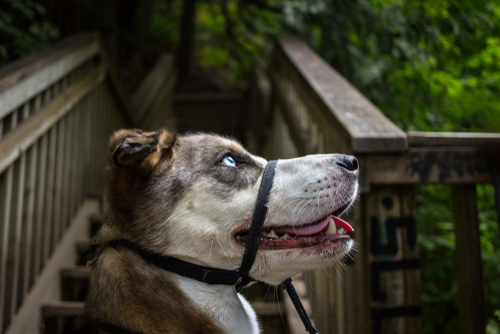Head Halters: The Device, the Uses and the Controversy
Updated on October 08, 2024

All featured products are chosen at the discretion of the Vetstreet editorial team and do not reflect a direct endorsement by the author. However, Vetstreet may make a small affiliate commission if you click through and make a purchase.
Head halters for dogs, such as the Gentle Leader, Halti or Snoot Loop, are devices that fit over a dog’s nose and neck. Not to be mistaken for a muzzle, they are a walking device that gives more control than a collar or harness. The basic premise of a halter is: Where the head goes, the body will follow. Like a halter on a horse, the leash attaches under the mouth. There may be some similarity between the head halter tightening on the muzzle and a mother dog correcting her puppies by putting her mouth over their nose. Head halters can be great training tools, but there is also the possibility for misuse. We recommend consulting your veterinarian to see if the head halter is the right fit for your dog.
Right for Some Situations
Not every dog is a candidate for a head halter, but they are valuable tools in certain training situations. For example, head halters may helpful for dogs with aggression issues. Owners with physical limitations might also find a head halter to be helpful when walking a hard-to-control dog.
The halter minimizes forward motion, such as pulling, and gives directional control. By pulling gently upward, the person can use the halter to close the dog’s mouth, which can help control nipping and mouthing. When training for a desired response like teaching a loose-leash walk, a head halter can be a great tool.
Potential for Misuse
Opponents of head halters note the risk of neck injury if the dog hits the end of the leash or sharp corrections occur, causing his head to snap back. Head halters that fit too tightly can also cause eye damage or rub fur off the muzzle. Some dogs also become distressed or depressed from the halter, especially if training is not done gradually.
The Right Fit
When used properly, the head halter can be a safe and effective tool, but proper fit is essential. Training and fitting should be done gradually by encouraging them to put their nose through the muzzle on their own accord. Testing out the fitting should only be done with treats, when the dog is relaxed, and over a period of time. When the fit is right, the dog tolerates the halter more because of the association with a treat. It should be loose enough for the dog to be able to pant, but fitted enough that it doesn’t slip off. If the fit is too tight, it will be uncomfortable for the dog and they may be unable to discern leash tightness.
Handlers should give plenty of slack to the dog when he is giving the desired response. If direction is given with the head halter, it should only be with a slight pressure, and never a jerking motion. The owner should immediately release any pressure as soon as the right response is given. When in a head halter, keep dogs on a short leash to avoid any leash-related injuries. If there is too much leash slack, the dog can pull with too much momentum and risk a neck injury.
Ensuring Success
Most head halters clip under the dog’s chin, adding the benefit of being able to redirect the dog to face his owner when needed. For dogs that bark on leash at other dogs or people, directional control is especially important. There are alternative versions of halters that clip on the back of the dog’s neck, behind the head. While they may not tangle under the feet as easily, they do not offer the directional control to turn the dog with ease, which is part of what makes a head halter effective.
Shorter-nosed dogs are more of a challenge to fit in head halters, as the nose strap easily falls off. Some halters make attachments for shorter-nosed dogs to keep the halter on the face, though a front clip harness may be preferred.
Those looking for a head halter can check out these recommended brands:
Gentle Leader: a simple, adjustable design that goes around the dog’s neck and nose.
Halti: One of the original head halters. Simply attaches to collar for added safety.
Snoot Loop: Another variety of head halter, with one version designed for short-nosed dogs.
Comfort Trainer Head Collar: Designed to fit more loosely, creating minimal pressure when worn.
More on Vetstreet.com:





